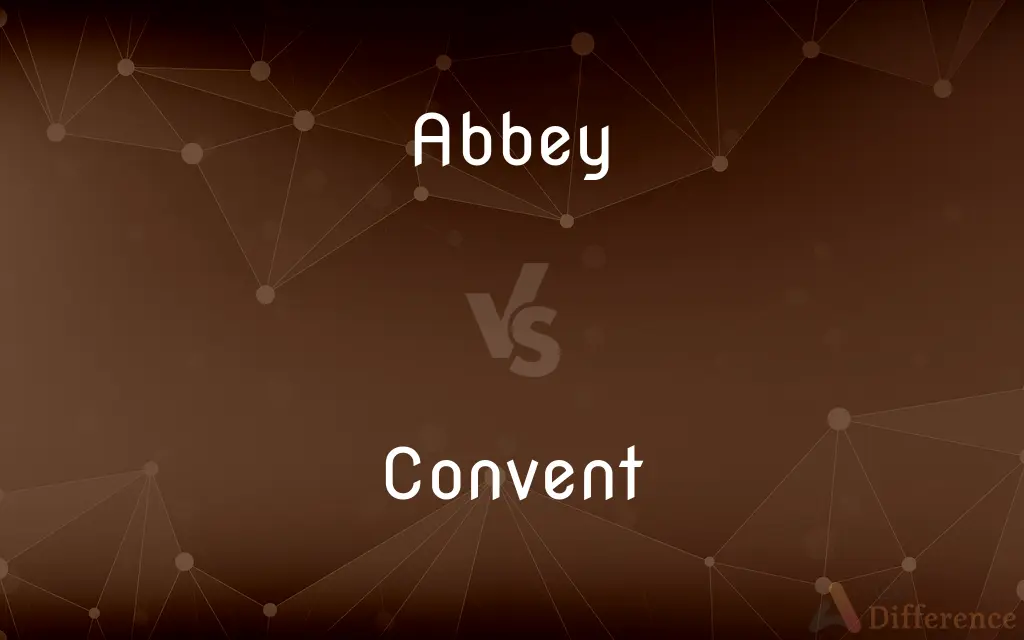Abbey vs. Convent — What's the Difference?
Edited by Tayyaba Rehman — By Urooj Arif — Updated on May 7, 2024
An abbey is a complex housing a community of monks or nuns under an abbot or abbess, often including a church and other buildings, while a convent is a religious residence specifically for nuns.

Difference Between Abbey and Convent
Table of Contents
ADVERTISEMENT
Key Differences
An abbey is a larger religious complex that usually hosts a community of monks or nuns and is overseen by an abbot (for monks) or abbess (for nuns). It often serves as a center of spiritual activity, worship, and work, featuring a church, cloister, and other buildings. In contrast, a convent is primarily a residence for nuns, focusing on religious practice and community living but generally smaller and more exclusively female in composition.
Abbeys often played a significant role in medieval Europe as centers of education, agriculture, and commerce. Convents, however, are more focused on the spiritual and social aspects of religious life, offering a sanctuary for women devoted to service and contemplation.
Abbeys usually include larger facilities and lands due to the community's agricultural or administrative needs. Convents typically have simpler facilities, reflecting the lifestyle and work of nuns.
Abbeys are often historic or architectural landmarks due to their historical significance and scale. Convents, while sometimes housed in notable buildings, are more modest, emphasizing the religious community over architectural grandeur.
Comparison Chart
Definition
Complex for monks or nuns under an abbot/abbess
Residence for nuns
ADVERTISEMENT
Oversight
Abbot or abbess
Mother Superior or similar
Size
Larger complex with multiple buildings
Smaller, single building or compound
Historic Role
Centers of commerce, education, agriculture
Spiritual retreat and service
Gender Composition
Can be male or female communities
Exclusively female communities
Compare with Definitions
Abbey
A complex housing monks or nuns, typically led by an abbot or abbess.
The abbey remains an important pilgrimage site to this day.
Convent
Led by a mother superior or similar leader.
The mother superior oversees the activities of the convent.
Abbey
An architectural complex often including a church, cloister, and library.
The medieval abbey featured beautiful Gothic architecture.
Convent
Typically smaller than an abbey and focused on community life.
The nuns maintain a quiet and contemplative atmosphere in the convent.
Abbey
A spiritual community focused on prayer and work.
The abbey fosters a quiet atmosphere for reflection.
Convent
A residence for women who have taken religious vows.
She decided to dedicate her life to faith and moved to a convent.
Abbey
Historically significant as a center of spiritual and administrative life.
During the Middle Ages, the abbey managed vast tracts of farmland.
Convent
Often provides charitable services like education or healthcare.
The convent offers educational programs for underprivileged girls.
Abbey
A structure that can have male or female religious communities.
Visitors can tour the abbey's historic grounds and chapels.
Convent
Emphasizes simplicity and devotion to religious service.
The convent's modest chapel is a tranquil place of worship.
Abbey
An abbey is a type of monastery used by members of a religious order under the governance of an abbot or abbess. Abbeys provide a complex of buildings and land for religious activities, work, and housing of Christian monks and nuns.
Convent
A convent is a community of either priests, religious brothers, religious sisters, monks or nuns; or the building used by the community, particularly in the Catholic Church, Lutheran churches, and the Anglican Communion.
Abbey
A monastery supervised by an abbot.
Convent
A Christian community of nuns living together under monastic vows
Maria entered the convent at the age of eighteen
Abbey
A convent supervised by an abbess.
Convent
A community, especially of nuns, bound by vows to a religious life under a superior.
Abbey
A church that is or once was part of a monastery or convent.
Convent
The building or buildings occupied by such a community.
Abbey
The office or dominion of an abbot or abbess.
Convent
A religious community whose members live under strict observation of religious rules and self-imposed vows.
Abbey
A monastery or society of people, secluded from the world and devoted to religion and celibacy, which is headed by an abbot or abbess; also, the monastic building or buildings.
From 1199 to 1203 William Punchard was the abbot of the abbey of Rievaulx, which was part of the Cistercian order of monks.
Convent
The buildings and pertaining surroundings in which such a community lives.
Abbey
The church of a monastery.
Convent
Synonym of nunnery, a female religious community and its residence.
Abbey
(British English) A residence that was previously an abbatial building.
Convent
(India) A Christian school.
Abbey
The church of a monastery.
Convent
A gathering of people lasting several days for the purpose of discussing or working on topics previously selected.
Abbey
A church associated with a monastery or convent
Convent
A coming together; a meeting.
Abbey
A convent ruled by an abbess
Convent
(obsolete) To call before a judge or judicature; to summon; to convene.
Abbey
A monastery ruled by an abbot
Convent
(obsolete) To meet together; to concur.
Convent
(obsolete) To be convenient; to serve.
Convent
A coming together; a meeting.
A usual ceremony at their [the witches] convents or meetings.
Convent
An association or community of recluses devoted to a religious life; a body of monks or nuns.
One of our convent, and his [the duke's] confessor.
Convent
A house occupied by a community of religious recluses; a monastery or nunnery.
One seldom finds in Italy a spot of ground more agreeable than ordinary that is not covered with a convent.
Convent
To meet together; to concur.
Convent
To be convenient; to serve.
When that is known and golden time convents.
Convent
To call before a judge or judicature; to summon; to convene.
Convent
A religious residence especially for nuns
Convent
A community of people in a religious order (especially nuns) living together
Common Curiosities
Are abbeys historically significant?
Yes, abbeys played vital roles in medieval society as centers of learning, agriculture, and commerce.
What is the main difference between an abbey and a convent?
An abbey is a larger religious complex that can house monks or nuns, while a convent is primarily a residence for nuns.
Who oversees an abbey?
An abbey is overseen by an abbot (for monks) or abbess (for nuns).
What architectural features are typical in an abbey?
Abbeys typically feature a church, cloister, dormitory, library, and other buildings.
What kind of activities are common in a convent?
Convents often focus on prayer, education, healthcare, and other charitable activities.
Is a convent generally smaller than an abbey?
Yes, convents are usually smaller and focused on simpler community living.
What roles do nuns typically have in a convent?
Nuns often serve in various capacities like education, nursing, or religious teaching.
Is a convent strictly for women?
Yes, a convent is exclusively for women who have taken religious vows.
Can an abbey be a tourist attraction?
Yes, many abbeys are historically significant and attract tourists for their architecture and history.
What type of religious orders can live in an abbey?
Various monastic orders, including Benedictines, Cistercians, and Trappists, can inhabit an abbey.
Are there modern abbeys?
Yes, modern abbeys continue to operate, adapting to contemporary needs.
Do abbeys still function today?
Yes, many abbeys still serve as active spiritual communities.
What distinguishes an abbot or abbess?
Abbots and abbesses are responsible for overseeing their monastic community's spiritual and administrative aspects.
Can an abbey include both male and female residents?
Not typically; abbeys are usually exclusively male or female.
Is a convent open to the public?
Some convents allow visitors, but others maintain strict privacy.
Share Your Discovery

Previous Comparison
Psychological vs. Mental
Next Comparison
Refundee vs. RefunderAuthor Spotlight
Written by
Urooj ArifUrooj is a skilled content writer at Ask Difference, known for her exceptional ability to simplify complex topics into engaging and informative content. With a passion for research and a flair for clear, concise writing, she consistently delivers articles that resonate with our diverse audience.
Edited by
Tayyaba RehmanTayyaba Rehman is a distinguished writer, currently serving as a primary contributor to askdifference.com. As a researcher in semantics and etymology, Tayyaba's passion for the complexity of languages and their distinctions has found a perfect home on the platform. Tayyaba delves into the intricacies of language, distinguishing between commonly confused words and phrases, thereby providing clarity for readers worldwide.
















































